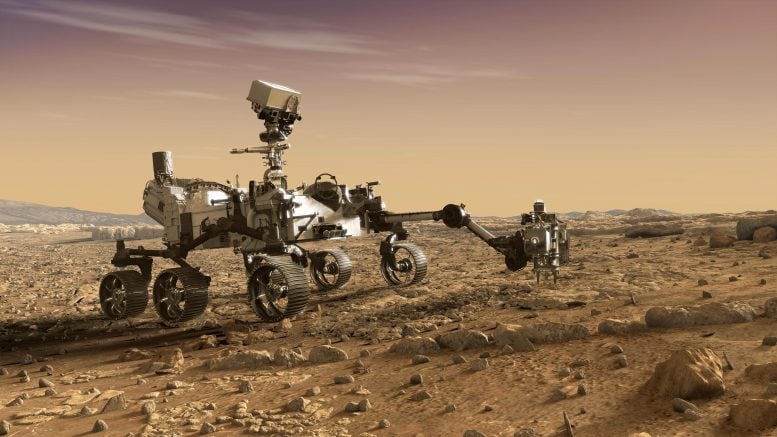
This illustration depicts NASA’s Mars 2020 rover studying rocks with its robotic arm. Credit: NASA/JPL-Caltech
The findings by rover scientists highlight the diversity of samples geologists and future scientists associated with the agency’s Mars Sample Return program will have to study.
Scientists with NASA’s Perseverance Mars rover mission have discovered that the bedrock their six-wheeled explorer has been driving on since landing in February likely formed from red-hot magma. The discovery has implications for understanding and accurately dating critical events in the history of Jezero Crater – as well as the rest of the planet.
The team has also concluded that rocks in the crater have interacted with water multiple times over the eons and that some contain organic molecules.
These and other findings were presented on December 15, 2021, during a news briefing at the American Geophysical Union fall science meeting in New Orleans.
Taken by Perseverance’s Mastcam-Z instrument, this video features an enhanced-color composite image that pans across Jezero Crater’s delta on Mars. The delta formed billions of years ago from sediment an ancient river carried to the mouth of a lake that once existed in the crater. Credit: NASA/JPL-Caltech/ASU/MSSS
Even before Perseverance touched down on Mars, the mission’s science team had wondered about the origin of the rocks in the area. Were they sedimentary – the compressed accumulation of mineral particles possibly carried to the location by an ancient river system? Or where they igneous, possibly born in lava flows rising to the surface from a now long-extinct Martian volcano?
“I was beginning to despair we would never find the answer,” said Perseverance Project Scientist Ken Farley of Caltech in Pasadena. “But then our PIXL instrument got a good look at the abraded patch of a rock from the area nicknamed ‘South Séítah,’ and it all became clear: The crystals within the rock provided the smoking gun.”
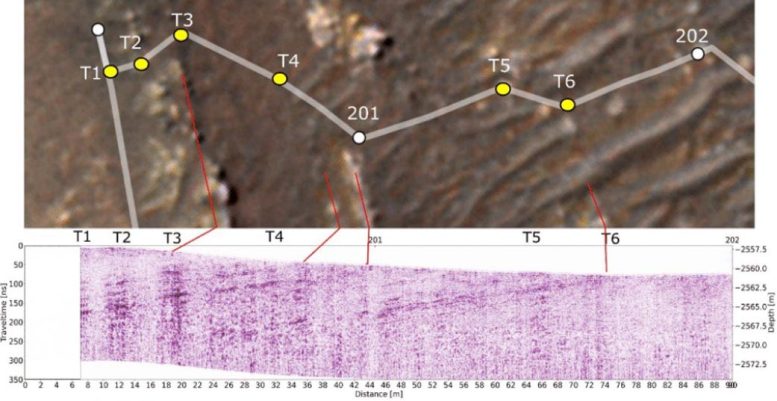
This graphic depicts Perseverance’s entry into “Séítah” from both an orbital and subsurface perspective. The lower image is a subsurface “radargram” from the rover’s RIMFAX instrument; the red lines indicate link subsurface features to erosion-resistant rocky outcrops visible above the surface. Credit: NASA/JPL-Caltech/University of Arizona/USGS/FFI
The drill at the end of Perseverance’s robotic arm can abrade, or grind, rock surfaces to allow other instruments, such as PIXL, to study them. Short for Planetary Instrument for X-ray Lithochemistry, PIXL uses X-ray fluorescence to map the elemental composition of rocks. On November 12, PIXL analyzed a South Séítah rock the science team had chosen to take a core sample from using the rover’s drill. The PIXL data showed the rock, nicknamed “Brac,” to be composed of an unusual abundance of large olivine crystals engulfed in pyroxene crystals.
“A good geology student will tell you that such a texture indicates the rock formed when crystals grew and settled in a slowly cooling magma – for example a thick lava flow, lava lake, or magma chamber,” said Farley. “The rock was then altered by water several times, making it a treasure trove that will allow future scientists to date events in Jezero, better understand the period in which water was more common on its surface, and reveal the early history of the planet. Mars Sample Return is going to have great stuff to choose from!”
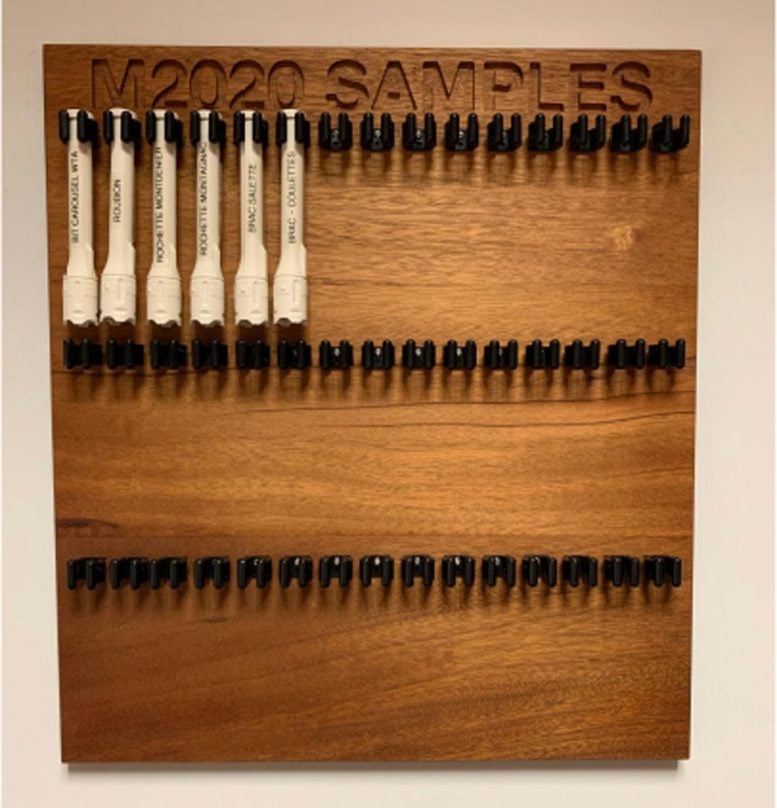
Six facsimile sample tubes hang on the sample tube board in this image taken in the offices of NASA’s Perseverance Mars rover. Credit: NASA/JPL-Caltech
The multi-mission Mars Sample Return campaign began with Perseverance, which is collecting Martian rock samples in search of ancient microscopic life. Of Perseverance’s 43 sample tubes, six have been sealed to date – four with rock cores, one with Martian atmosphere, and one that contained “witness” material to observe any contamination the rover might have brought from Earth. Mars Sample Return seeks to bring select tubes back to Earth, where generations of scientists will be able to study them with powerful lab equipment far too large to send to Mars.
Still to be determined is whether the olivine-rich rock formed in a thick lava lake cooling on the surface or in a subterranean chamber that was later exposed by erosion.
Organic Molecules
Also great news for Mars Sample Return is the discovery of organic compounds by the SHERLOC (Scanning Habitable Environments with Raman & Luminescence for Organics & Chemicals) instrument. The carbon-containing molecules are not only in the interiors of abraded rocks SHERLOC analyzed, but in the dust on non-abraded rock.
Confirmation of organics is not a confirmation that life once existed in Jezero and left telltale signs (biosignatures). There are both biological and non-biological mechanisms that create organics.
“Curiosity also discovered organics at its landing site within Gale Crater,” said Luther Beegle, SHERLOC principal investigator at NASA’s Jet Propulsion Laboratory in Southern California. “What SHERLOC adds to the story is its capability to map the spatial distribution of organics inside rocks and relate those organics to minerals found there. This helps us understand the environment in which the organics formed. More analysis needs to be done to determine the method of production for the identified organics.”
The preservation of organics inside ancient rocks – regardless of origin – at both Gale and Jezero Craters does mean that potential biosignatures (signs of life, whether past or present) could be preserved, too. “This is a question that may not be solved until the samples are returned to Earth, but the preservation of organics is very exciting. When these samples are returned to Earth, they will be a source of scientific inquiry and discovery for many years,” Beegle said.
‘Radargram’
Along with its rock-core sampling capabilities, Perseverance has brought the first ground-penetrating radar to the surface of Mars. RIMFAX (Radar Imager for Mars’ Subsurface Experiment) creates a “radargram” of subsurface features up to about 33 feet (10 meters) deep. Data for this first released radargram was collected as the rover drove across a ridgeline from the “Crater Floor Fractured Rough” geologic unit into the Séítah geologic unit.
The ridgeline has multiple rock formations with a visible downward tilt. With RIMFAX data, Perseverance scientists now know that these angled rock layers continue at the same angle well below the surface. The radargram also shows the Séítah rock layers project below those of Crater Floor Fractured Rough. The results further confirm the science team’s belief that the creation of Séítah preceded Crater Floor Fractured Rough. The ability to observe geologic features even below the surface adds a new dimension to the team’s geologic mapping capabilities at Mars.
More About Perseverance
A key objective for Perseverance’s mission on Mars is astrobiology, including the search for signs of ancient microbial life. The rover will characterize the planet’s geology and past climate, pave the way for human exploration of the Red Planet, and be the first mission to collect and cache Martian rock and regolith (broken rock and dust).
Subsequent NASA missions, in cooperation with ESA (European Space Agency), would send spacecraft to Mars to collect these sealed samples from the surface and return them to Earth for in-depth analysis.
The Mars 2020 Perseverance mission is part of NASA’s Moon to Mars exploration approach, which includes Artemis missions to the Moon that will help prepare for human exploration of the Red Planet.
JPL, which is managed for NASA by Caltech in Pasadena, California, built and manages operations of the Perseverance rover.



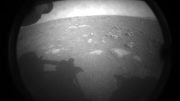

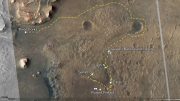
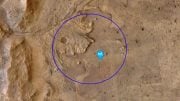

Babu G. Ranganathan*
(B.A. Bible/Biology)
POSSIBLY MILLIONS OF TONS OF VOLCANIC EARTH SOIL REACHED MARS (Newsweek)
A Newsweek article of September 21, 1998, p.12 mentions the high possibility of Earth life on Mars because of millions of tons of Earth soil ejected into space from ancient volcanic explosions. “We think there’s about 7 million tons of earth soil sitting on Mars”, says USC scientist Kenneth Nealson. “You have to consider the possibility that if we find life on Mars, it could have come from the Earth” [Weingarten, T., Newsweek, September 21, 1998, p.12]. This may also explain why life forms may exist on Venus, again because they originated from Earth.
In the Earth’s past there was powerful volcanic activity which could have easily spewed dirt and rocks containing microbes and life into outer space which not only could have eventually reached Mars but also ended up traveling in orbit through space that we now know as meteors, comets, and asteroids. This would mean life forms found in meteorites originated from Earth in the first place.
Secular scientists have a different explanation from creationist scientists on the volcanic eruptions of the Earth’s past. Creation scientists believe, as Genesis teaches, that as the fountains of the deep were opened to release water for the world-wide flood the force of the eruptions could have indeed spewed great amounts of earth soil into space.
Life could not have evolved. A partially evolved cell would quickly disintegrate under the effects of random forces of the environment, especially without the protection of a complete and fully functioning cell membrane. A partially evolved cell cannot wait millions of years for chance to make it complete and living! In fact, it couldn’t have even reached the partially evolved state.
Having the right conditions and raw material for life do not mean that life can originate or arise by chance. Stanley Miller, in his famous experiment in 1953, showed that individual amino acids (the building blocks of life) could come into existence by chance. But, it’s not enough just to have amino acids. The various amino acids that make-up life must link together in a precise sequence, just like the letters in a sentence, to form functioning protein molecules. If they’re not in the right sequence the protein molecules won’t work. It has never been shown that various amino acids can bind together into a sequence by chance to form protein molecules. Even the simplest cell is made up of many millions of various protein molecules.
The probability of just an average size protein molecule arising by chance is 10 to the 65th power. Mathematicians have said any event in the universe with odds of 10 to 50th power or greater is impossible! The late great British scientist Sir Frederick Hoyle calculated that the odds of even the simplest cell coming into existence by chance is 10 to the 40,000th power! How large is this? Consider that the total number of atoms in our universe is 10 to the 82nd power.
Also, what many don’t realize is that Miller had a laboratory apparatus that shielded and protected the individual amino acids the moment they were formed, otherwise the amino acids would have quickly disintegrated and been destroyed in the mix of random energy and forces involved in Miller’s experiment.
Miller’s experiment produced equally both left-handed and right-handed amino acids, but all living things strictly require only left-handed amino acids. If a right-handed amino acid gets into the chain the protein won’t work.
There is no innate chemical tendency for the various amino acids to bond with one another in a sequence. Any one amino acid can just as easily bond with any other. The only reason at all for why the various amino acids bond with one another in a precise sequence in the cells of our bodies is because they’re directed to do so by an already existing sequence of molecules found in our genetic code.
Of course, once you have a complete and living cell then the genetic code and biological machinery exist to direct the formation of more cells, but how could life or the cell have naturally originated when no directing code and mechanisms existed in nature? Read my Internet article: HOW FORENSIC SCIENCE REFUTES ATHEISM.
Visit my newest Internet site: THE SCIENCE SUPPORTING CREATION
Author of popular Internet article, TRADITIONAL DOCTRINE OF HELL EVOLVED FROM GREEK ROOTS
* I have had the privilege of being recognized in the 24th edition of Marquis “Who’s Who In The East” for my writings on religion and science, and I have given successful lectures (with question and answer time afterwards) defending creation from science before evolutionist science faculty and students at various colleges and universities.
What a moron.
Yes, because this study was worth millions of dollars and fed 100,000 refugees right? No!!!! Then you are morons.
I believe in GOD – not as the father of Jesus, but the one who made the impossible to become probable.
What the the possibility of light to form a particle that has gravity? What is the possibility of the sun to rise tomorrow?